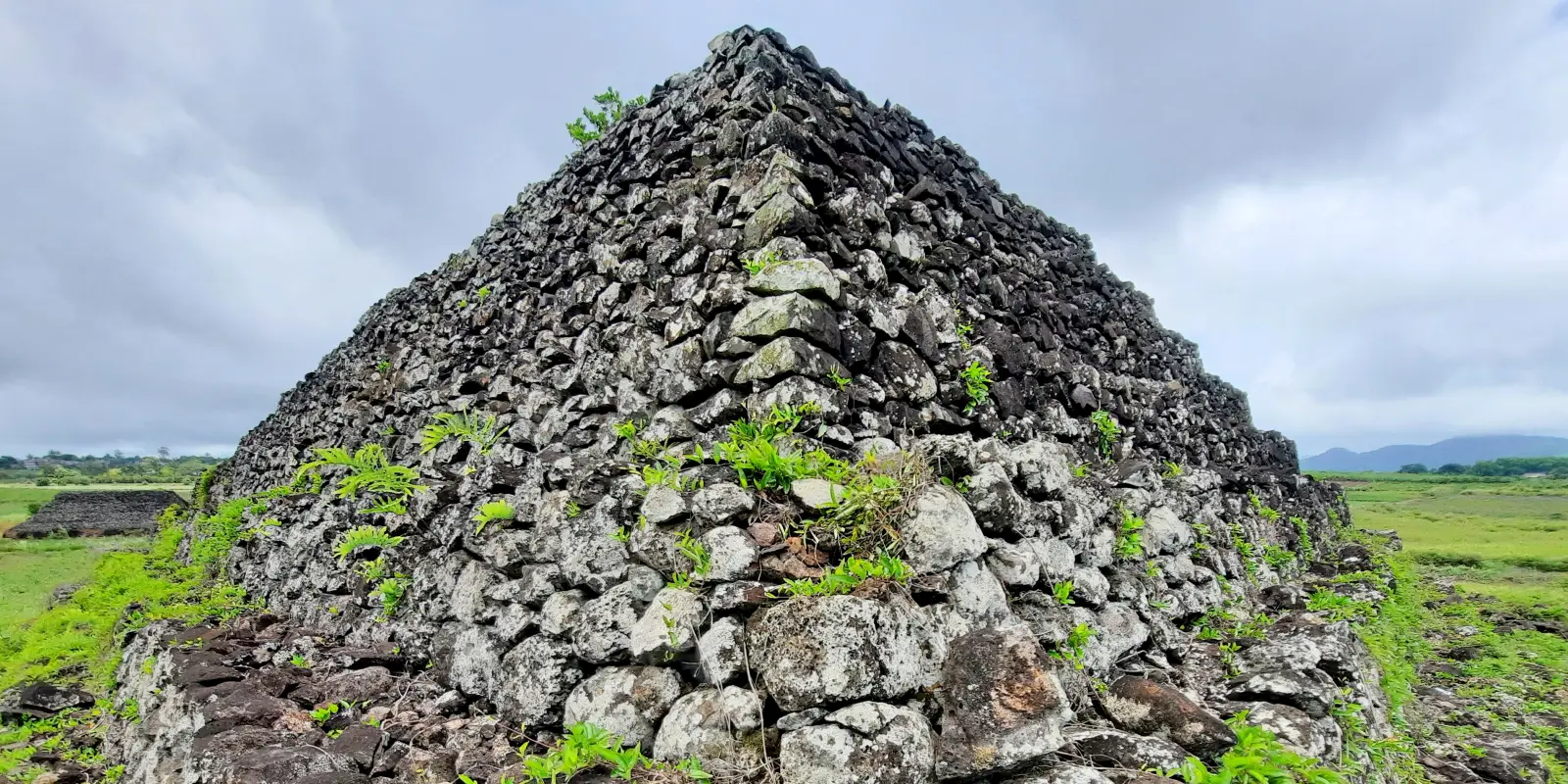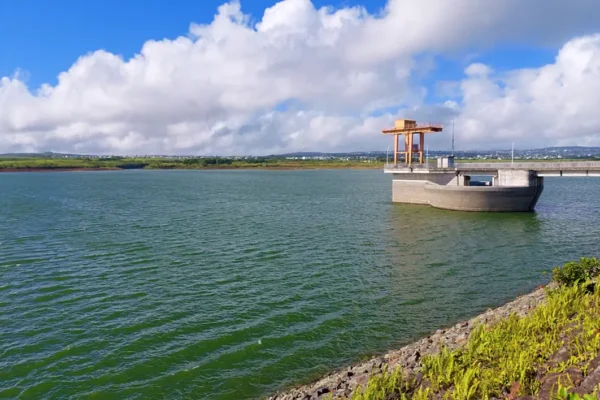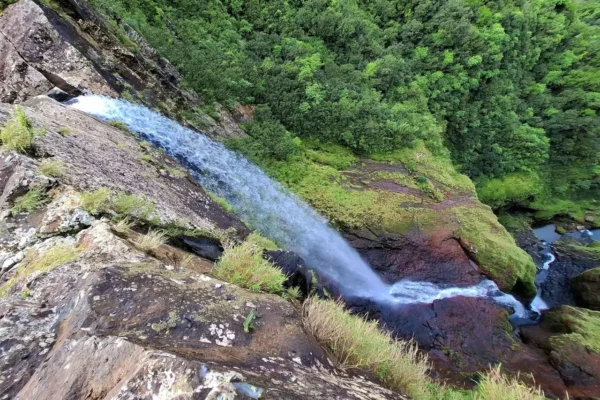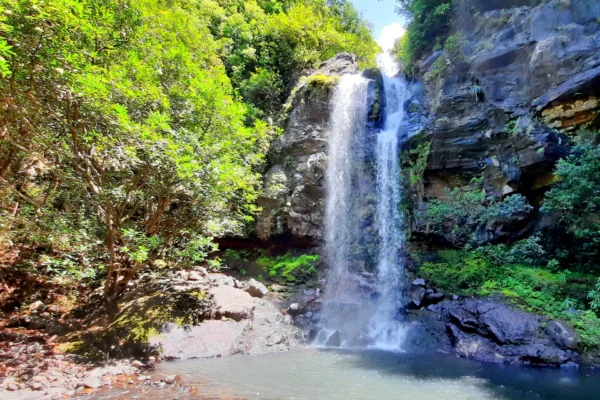Mauritius, a small island in the Indian Ocean, is riddled with mysteries. For centuries legends have existed in our communities, without forgetting superstitions from generation to generation. For some years, a location from the South of the island has become popular on social media. It is the pyramids of Plaine Magnien. Many persons asked about the origin, and unfortunately, falsehoods overcame truths. On social media, everyone knows better than others. Some readers will not bother to verify the information given.
Today, I have decided to write an article on this topic after researching massively to deliver the truth.
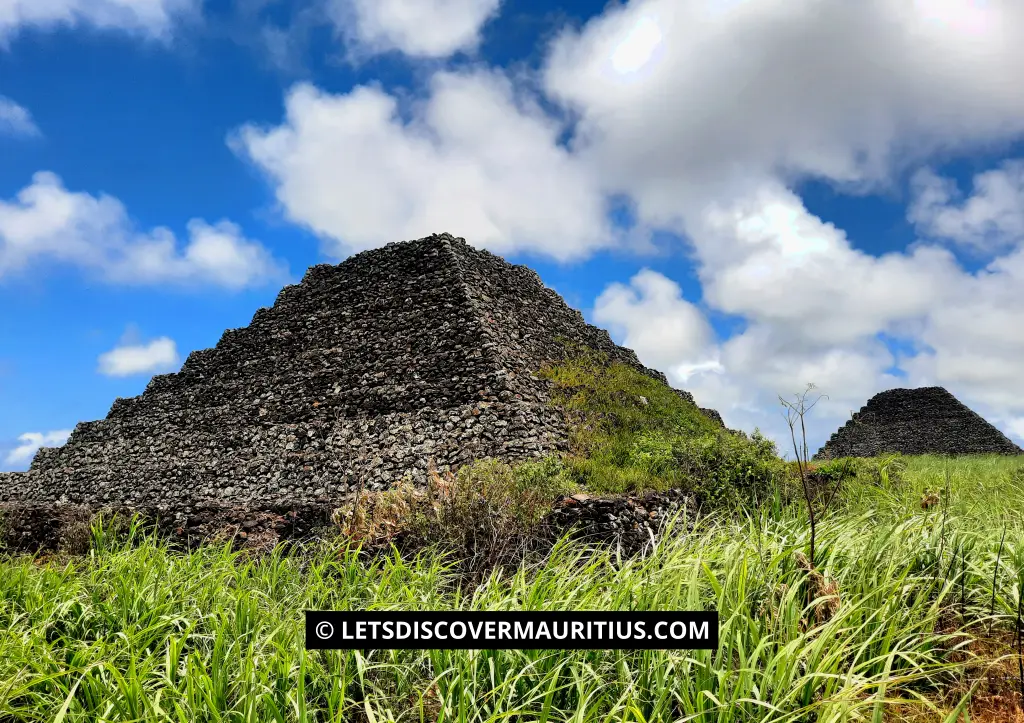
Plaine Magnien, Not Just The Airport
This beautiful village in the Grand Port District has a rich historical past. The origin of the name is François Magnien, who was a concessionaire in the early 1830s. The international airport, Sir Seewoosagur Ramgoolam, is located in Plaine Magnien. For most Mauritians, the airport will be the first thing on their mind when we talk about this village. But, the village is more about what you think. The airport was built on the property of the Plaisance sugar mill. The sugar mill was built in 1844 and demolished in 1925 after Amédée Hugnin bought the property in the early 1890s. After that, Mon-Trésor Mon Désert acquired it. The British Army used the site of Plaisance as a runway for military planes that patrolled around the island and evaluated the weather conditions of Mauritius. The rest is history until it became a national airport in the 1970s.
Moreover, there were other sugar estates around Plaine Magnien, such as Richfield, Mon-Trésor, Union Vale, Sauveterre, Mare D’Albert, La Rosa, Mon Désert, etc. Another historical fact, the fourth Governor-General, Sir Dayendranath Burrenchobay, was born in the village in 1919. So, it was indeed a busy village a long time ago. The agricultural sector is still important in the community. Developments in infrastructures have changed the landscapes. The past sugar estates have been closed or even replaced by other infrastructures.
But, our concern is about these rocky structures in the sugarcane fields of Plaine Magnien, which we refer to as pyramids.
The Mauritian Pyramids, Exposed!
In 2009, a writer and researcher, A.G., made an explosive revelation on Mauritius. She narrated that the monuments of Plaine Magnien share similar structures to those monuments on the island of Tenerife. Furthermore, she added that the monuments were a platform for astronomical purposes and were built by the alignment of the two solstices (June 20 or 21 and December 21 or 22). And she went further, that the monuments dated back to the Egyptian era. Her hypothesis went viral on social media. And most people believed in them.
These so-called pyramids are situated next to ex-Mon-Trésor sugar estates. There is now a stone crusher factory, but the two chimneys of the sugar mill are still there. Mon-Trésor sugar estates ceased their operation in the 1880s after being annexed by Mon-Désert. The amalgamation became Mon-Trésor Mon Désert. If you visit these monuments, a plate on one of them says, “Protected by the National Monument Board”, installed in the mid-1980s. The monuments, however, are not designated as national heritage. There is a distinction between them.
In 2011, Phillippe D’Unienville from Société de l’Histoire de l’Île Maurice made a speech on them. His research was collaborated by Guy Rouillard. His research led to amazing discoveries. A few of the crucial details are as follows:
When, Why, How & For How Long?
These pyramids do not exceed 12 meters in height. Their construction began in the late 1930s by the laborers of different sugar estates, particularly Mon Trésor and Union Vale. Even though those sugar mills were already closed, in the 1880s and 1910s, laborers were still working for the estates.
The reason may surprise you! The reality of their construction was just to discard those rocks from the sugarcane fields. In many corners of Mauritius, there were stockpiles of rocks in sugarcane fields. In the North, there were plenty of them. Gradually, they disappeared, and stone crusher factories used them to produce pebbles or macadam.
There were no advanced construction machines like today at the start of the 1930s. Thus, small tractors transported them to their corresponding locations. Laborers used baskets to carry those rocks. It was a heavy task for them to discard those quantities of rocks from the fields elsewhere. In addition to that, they used coconut lines to align the stones while constructing the monuments. Even today, some masons use lines (nowadays with nylon) to align in construction. Then, they filled a base roughly with huge rocks and soils and created the facades with squared stones, considering the alignment to make the monument attractive like a pyramid. Some laborers were specialists in cutting and carving stones.
The construction took place from the 1930s to the 1960s. The total number of those monuments was more than twenty. At the end of the 1980s, both the administration of Union Vale and Mon Trésor Mon Désert decided to keep only seven of them. The rest were abandoned in a deplorable state, demolished, and disappeared. They decided to protect only these seven monuments. This is why there is that plate warning they are protected, on one of them.
Testimonials From Those Who Know About These Monuments
Here are two testimonials whose relatives were working in the discarding process of those rocks. As the process lasted in the 1960s, it is difficult, in fact, impossible to get a witness from that era who worked in the field to testify today. Maybe most of them are not alive anymore. Only their children can narrate what happened. Fortunately, I found two persons who agreed to contribute to the truth:
“My father, P.R, worked for La Barraque SE (today Omnicane). Whenever it was time to re-plant some fields he would have the bulldozer push and pile up all the rocks in the middle of the field and then would have neat walls built all around the mound of rocks in the shape of a half pyramid. My uncle, D.R, worked in Union Vale SE (annexed to MDMT). The same process in the fields, except that in Union Vale the pyramids were very much neater. Whenever they met, they always had this silly discussion on who built the best Meule/Pyramid. I would like to point out though that all the sugarcane fields in those days were strewn with enormous mounds of stones. Anyone flying into Mauritius in the 60s/70s wandered and remarked on the purpose of those piles of rocks. Then came mechanization, and today the fields are neat and free of piles of rocks.” -Dawn B, 74, Tamarin
“When I was around seven years old, there was a great event in the village. There were two earth-moving bulldozers and the supporting trailers, diesel tanks, clawing the soil for the big boulders. They were piling them up in an orderly fashion. My father accompanied me to watch with most of the boys of Plaine Magnien. Whether it was to reflect a celestial body or ceremonial, I cannot confirm, but I find them pleasant if a person with astrology/astronomy knowledge tries to simulate the position of the pyramids about those nearby. That happened at the beginning of the 1960s.” -Jean-Claude W, 66, UK
Hence, based on these two testimonials, it is no doubt the workers were the builders. As stated earlier, earth-moving equipment was used from the end of the 1950s, which Jean-Claude W witnessed.
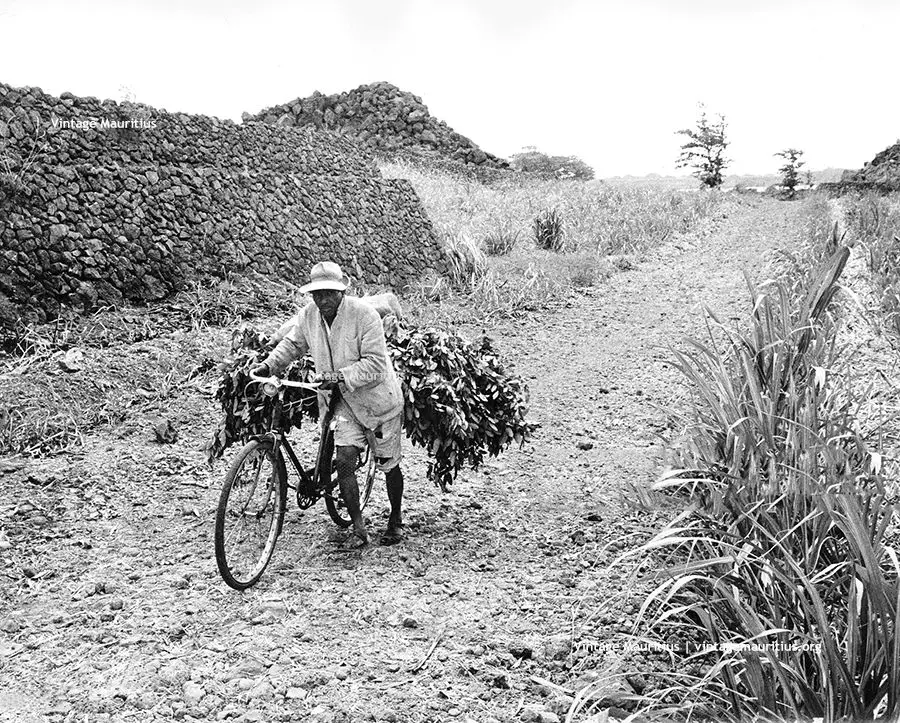
A photograph taken in the 1960s showing a worker passing by some of the structures. Some of them, as you can see, were obviously not finished yet. The final batch of Mauritius “pyramids” were finished in the 1960s, as mentioned earlier as well. The structures in question are from Plaine Magnien, according to the picture up top.
Contradictions Of Popular Tales About These Pyramids
Conspiracy theorists and pseudo-scientists believe these monuments were built by previous civilizations and date back thousands of years. A complete FALSE! Before the 1940s, there is no factual record, no proof on old maps, no written evidence, and no testimonies of these monuments. A.G., the writer and researcher who revealed they originated from the Egyptian era has not only embarrassed herself but also insulted the intelligence of those who believed in her. The Arabs were the first to state Mauritius on their navigational maps in the 1200s, and according to one theory, the Phoenicians could have discovered Mauritius, except there is no evidence. And we were not visited by a civilization older than 5000 B.C. A complete shambles!
Others think because they were built so perfectly, shows no one on earth would have created such a monument. Another nonsense! If you climb one of these pyramids, you may notice how bad the structure is. The stones were placed roughly. We have buildings dating back to the 18th century, built by the slaves and Pondicherry workers, which still stand perfectly today. The stones were perfectly aligned, and those people were humans, not aliens. Humans have built marvelous architecture for thousands of years.
Coming back to the Tenerife pyramids, scientists and archeologists have revealed they were built by laborers as well. Choose whom you want to believe, prominent scientists and archeologists with pieces of evidence or a so-called writer who came from nowhere with a featherweight hypothesis? It is up to you to decide!
INTERVIEW: Jean Marie Chelin Talks On The Plaine Magnien Pyramids
Jean Marie Chelin is a well-known historical book author in Mauritius and has participated in numerous speeches. He has accepted to share his knowledge and opinions on these monuments, as he knows very well about their existence.
QUESTION: You spent so many years in historical research and author of several books. Tell us, what do you know more about the pyramids or monuments of Plaine Magnien?
JEAN MARIE CHELIN: “I have known the stone piles of Plaine Magnien for over 40yrs. I have met several persons who instructed the laborers to build the stone piles in winter in 1975 and 1980, at Sauveterre and Mon-Trésor sections. Note that these piles of rocks were built from 1950-to 1960. Some laborers were specialists, according to an employee of the Sauveterre section. They were called PARMENTEURS and gave guidelines to their colleagues for placing the stones.”
QUESTION: Some persons revealed these monuments are linked with a past civilization or extraterrestrial beings. Your thoughts?
JEAN MARIE CHELIN: “I don’t think that extraterrestrial beings have anything to do with these piles of rocks. Any allusion to this is from sick persons.”
QUESTION: These monuments are not national heritage but, are protected by the government. Do you think they must be a national heritage?
JEAN MARIE CHELIN: “These stone piles can be protected as they are the result of the work of laborers.”
Recommended books from Jean Marie Chelin to buy at any bookstores are as follows: Histoire Maritime de L’Ile Maurice (3 Volumes), PORT-LOUIS – Histoire D’une Capitale (2 Volumes), and Tablisman – Histoire de l’industrie sucrière à l’île Maurice.
The Truth Is Bitter…
The problem is that we choose what we want to believe, even if the truth is different. Certain people live in denial, no matter how hard and harsh the truth is. They prefer to choose what they think to feel good about. It is all psychology that some persons choose falsity and alternative facts. The truth is that no extraterrestrial beings built those pyramids, nor did past civilizations. They were well-built by sugar estates laborers, who have contributed massively to the development of this country. An alternative belief about these monuments means a total disrespect to those laborers who worked hard without machines or advanced technologies to carry those rocks.
It is important to mention that someone on Facebook twisted the minds of many Mauritians by posting bogus information on the Mauritian pyramids, including AI-generated maps and posters. I hope this post has brought some light on the origins of these monuments. Do feel free to contact me with any questions or if you know something about them that I can include, particularly a past relative who worked in their construction.
Author & References

Author: Ali J | Date Published: May 28, 2022 | Last Updated: May, 19, 2025
References: Guy Rouillard (Histoire des domaines Sucriers de l’Ile Maurice), Société de l’Histoire de l’Île Maurice – Les Pyramides D’Union Vale (Légendes et Réalités) by Phillippe D’Unienville, Allister MacMillan (MAURITIUS: Illustrated – Historical and descriptive commercial and industrial facts, figures and resources).
Subscribe For Newsletters
Not just newsletters, but you may enjoy free vouchers, coupons, activity deals and many others while subscribing…

